Kayak is a versatile water vessel that comes in different shapes, sizes, and styles. There are several types of kayaks, including sit-on-top, recreational, whitewater, tandem, and many more. Kayaking has become a popular activity among outdoor enthusiasts, and it can be enjoyed by both beginners and seasoned paddlers alike.
In this blog post “what is a tandem kayak?”, we will explore the pros and cons and many other points of tandem kayaks. This style is great if you’re looking to paddle with your partner or friend, as it allows you to share the paddling workload and enjoy each other’s company while on the water.
Contents
Contents
What is a Tandem Kayak?
A tandem kayak is one of the many types of kayaks available. Unlike a regular solo kayak which only fits one person, a tandem kayak is designed for two paddlers to use at once. It is usually a small and lightweight boat that features a closed top with tapered ends.

A tandem usually measures between 18-24 feet in length and is much broader than a solo kayak. This extra width allows for two people to paddle simultaneously using double-bladed paddles.
It is recommended that the more knowledgeable and experienced paddler be placed at the back of the boat as they will be responsible for controlling the boat, setting the pace, and continuing to paddle even when the other person stops or takes a break.
Why Choose a Tandem Kayak?
Tandem kayaks are a great choice for those looking to paddle with a partner. They offer good stability and speed, perfect for family or friends to explore together safely. It is also a great way for an experienced paddler to take a smaller child with them on the adventure.

Furthermore, it can be a fun and enjoyable experience for both people to paddle together and enjoy the sights. Tandem Kayaks are faster than solo kayaks and have a higher center of gravity. They are also easier to paddle, making them suitable for paddling in rougher waters or when the wind is stronger. It has wider space and stability which is perfect for beginners.
What are the Pros of a Tandem Kayak?
There are many advantages to using a tandem kayak, especially if you’re paddling with another person. The following are a few of the most prominent benefits:
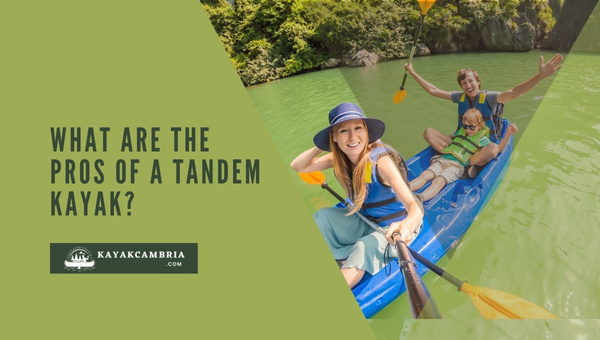
- Good for Beginners: Tandem kayaks are great for beginners who have never been on a kayak before, as starting with another person on board will be more comfortable than starting alone. It is an excellent way to get introduced to the world of kayaking in a much safer and more comfortable way.
- Easy to Store: It is much easier to store a tandem kayak than two single-person kayaks. Whether you’re heading out on a camping trip and have limited storage space or just don’t want to store two boats in your garage, a tandem kayak will fit the bill perfectly.
- Plenty of Packing Space: The two-person kayak offers a great deal of storage space more than enough for packing all your camping gear. This extra space is very convenient when you’re paddling solo or with the company, as either way, you don’t have to think about storing two kayaks during trips.
- Good Stability and Speed: Tandem kayaks are much more stable than a narrower solo kayak and therefore the chances of capsizing are significantly reduced. Additionally, it is less likely to tip over as they have a larger center of gravity due to its size. Moreover, bigger doesn’t always mean slower. Longer and broader tandems can traverse the water with less resistance and they’re easier to paddle.
- Perfect for Family and Friends: Tandem kayaking is a great way for families and friends to enjoy the outdoors. This is a safe and exciting activity in that everyone in the family can participate. This makes it easier than a solo kayak to keep an eye on your child while on the water.
What are the Cons of a Tandem Kayak?
There are a few cons that come along with using tandem kayaks, including:
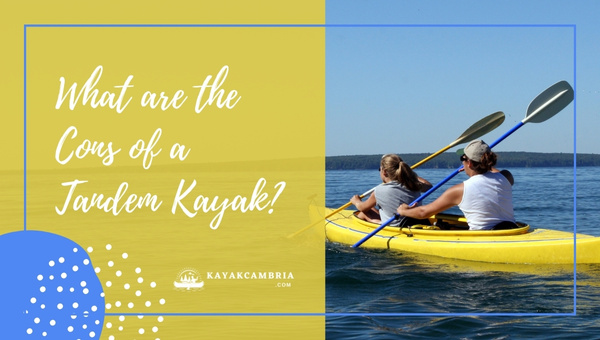
- Heavy: Quality tandem kayaks can be very heavy and require two adults to help carry them. This can cause problems if you’re looking to venture out alone or with a child or furry friend. These boats typically weigh anywhere from 35 to 50 kilos.
- Little bit Expensive: One tandem kayak would indeed be cheaper than two one-person kayaks, but if you are buying a good quality tandem kayak then this won’t be true. Good quality tandem kayaks will often have a rudder, making them more expensive than their single-kayak counterparts.
- Less Freedom: If you’re used to kayaking alone, tandem kayaks may offer less freedom. This is because it limits your movement as you cannot control it in the water all alone. Additionally, if you cannot find a kayaking partner one day to join, you will end up not going at all, and that can be quite frustrating.
- Different Learning Approach: It is not just a one-person operation. You aren’t the only one controlling the action of a two-person kayak, so it will be harder to understand how each of your movements and actions is affecting the boat.
- Negative Team Work: This is probably the biggest challenge with tandem kayaks. Learning to work together effectively in a tandem boat can be a challenge for couples and friends alike. It takes some good practice and patience while you synchronize with your paddling partner for better control.
How to Paddle a Tandem Kayak?
Before hitting the water, you should familiarize yourself with the basics of paddling a tandem kayak. Here are the main points to consider before starting:
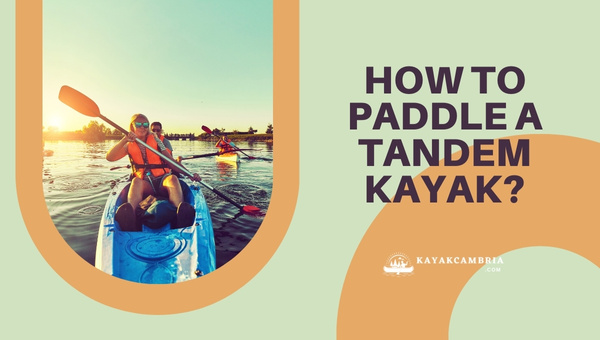
1. Synchronized Paddling
As you will be paddling with two people, it is important to paddle in unison. It is always better for the person in the back seat to just follow the paddler in front of them. The person in front should do the leading with quick and equal strokes. By paddling in sync, you’ll create a more efficient stroke and avoid the clashing of paddles.
2. The Experienced Paddler in the Back
It is always better to have the more experienced paddler in the back seat, as they can guide the other and help with steering. They will also be able to keep a steady pace while still allowing their partner to take breaks if needed. It is important to make sure both paddlers are comfortable and can move freely.
3. Turning the Kayak
Turning the kayak can be a bit more difficult than a single kayak, but if you have two people on board who know what they are doing, they will have a much easier time controlling than a person in a single kayak. Some tandem kayaks come with a rudder, which helps keep the boat running straight or to make some corrections in the tracking.
To turn your kayak, the front paddler will need to perform a forward sweep on one side while the paddler in the back needs to take a reverse sweep on the opposite side of the kayak. If they work together simultaneously they can turn a boat quickly.
Tips To Paddle A Tandem Kayak
There are some important things to remember when paddling a tandem kayak. Factors like speed, coordination, and communication are all important for a successful paddle. Here are some tips to help you get started:
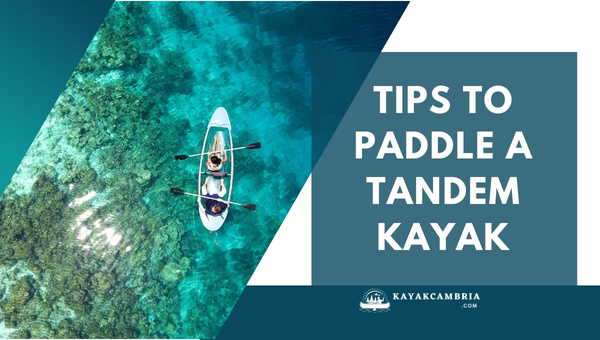
- Synchronize strokes: If both people in the boat don’t paddle together at the same time, it can cause instability in the kayak and make paddling more difficult. It is important to take strokes on the same side at the same time so that there is no chance of your blades hitting each other and travelling in the water faster.
- Know your roles: It is important to have an experienced paddler sitting in the rear position as this person is in charge of steering. This means that the front paddler dictates the pace and the rear paddler will make sure it runs smoothly with their strokes. They should also perform a backward stroke at the same time as the front paddler performs a forward stroke.
- Be Patient: Paddling a tandem kayak can be frustrating at times and it takes time to learn how to paddle as a team. Don’t give up if you are having some difficulties, just remember that practice makes perfect.
Pros and Cons of Single Kayak
As we have discussed above, there are both pros and cons of a tandem kayak. The same goes for single kayaks as well. Here are some of the benefits and drawbacks that come with single kayaks:
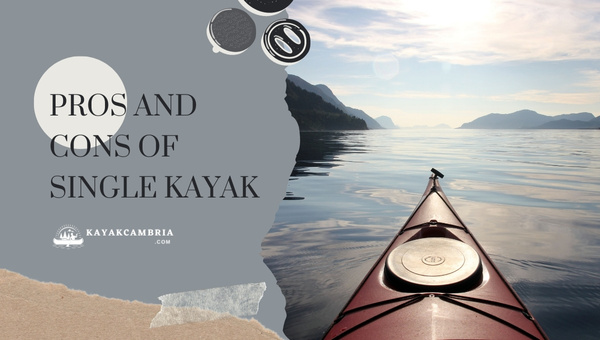
Pros of Single Kayak:
There are many advantages of a single kayak, including:
- Freedom to Paddle: Single kayaks provide the ultimate freedom when it comes to paddling. You can go where you want when you want, and enjoy the scenery along the way without having to worry about coordinating with another paddler.
- Lightweight: A single kayak is typically much lighter than a tandem kayak, making it easier to transport and store in smaller spaces. It is also much easier to control in the water. You don’t need help from anyone to move it from one place to another.
- Plenty of Activities: Single kayaks offer a greater variety of paddling activities as they are more maneuverable than two-person kayaks. It is easier to explore tight rivers or creeks, and you can also surf waves if you’re an experienced paddler.
Cons of Single Kayak:
We can’t ignore the drawbacks of a single kayak either, and these include:
- Lack of Socializing: Kayaking in pairs with your partner or children is much more fun than doing it alone. On a single kayak, you won’t have the opportunity to socialize and share the experience with someone else.
- Little Bit Expensive: If you and your partner or child love kayaking, it will be much more expensive to buy two single kayaks than one tandem. And storage can be a hassle with two single kayaks, so a tandem kayak is usually the better option.
Which is Best: Tandem or Single Kayaks?
Fortunately, if you want the best of both worlds and cannot make up your mind between a tandem and a single kayak, then there are converting kayaks available in the market nowadays. These come with movable seats that allow for easy conversion from tandem to solo in just one step. Some even have a “jump seat” molded into the kayak for added convenience.
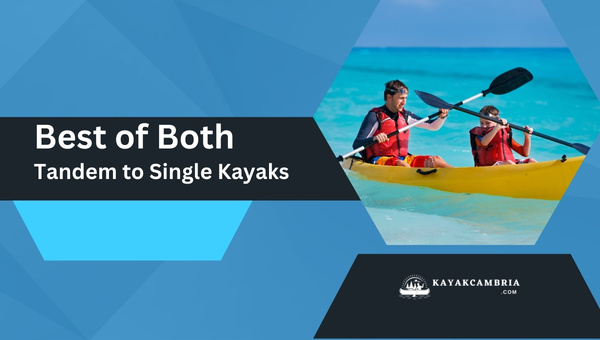
The downside to these conversion kayaks is that the center position if using the one with the molded-in seat, may not be as comfortable for long paddling trips. In addition, they could also be a little heavier than regular single kayaks since the frames need to accommodate the additional seat. No matter what type of kayak you choose, you will have the opportunity to enjoy your favorite water activities with friends and family while having fun outdoors.
Frequently Asked Questions
1. What’s the difference between a tandem kayak and a regular kayak?
A tandem kayak is a larger kayak designed to hold two people, while a regular kayak typically holds just one person. Tandem kayaks offer more speed and stability than solo kayaks and are better suited for rougher waters or stronger winds.
2. Can one person ride a tandem kayak?
Yes, one person can ride a tandem kayak. Although it is more difficult to control and maneuver, it is still possible.
3. What are the cons of tandem kayaks?
The main cons of tandem kayaks are less freedom, different learning approaches, and negative teamwork. Additionally, they tend to be more expensive than their single-kayak counterparts.
4. Is tandem kayaking easy?
Tandem kayaking can be more difficult than solo kayaking due to the coordination and communication necessary between the two paddlers. However, with practice and patience, tandem kayaking can become quite easy.
5. Are tandem kayaks stable?
Tandem kayaks are generally more stable than their single-kayak counterparts due to their wider hulls and higher centers of gravity. This makes them great for beginners and those looking to explore rougher waters.
Final Words
Tandem kayaks offer a great way for two people to explore and experience the outdoors together. They are more stable, faster, and easier to paddle than single kayaks, making them suitable for a variety of activities such as fishing, touring, or just leisurely paddling.
We hope that our article “what is a tandem kayak?” has helped answer your questions. Good luck, and happy paddling!

